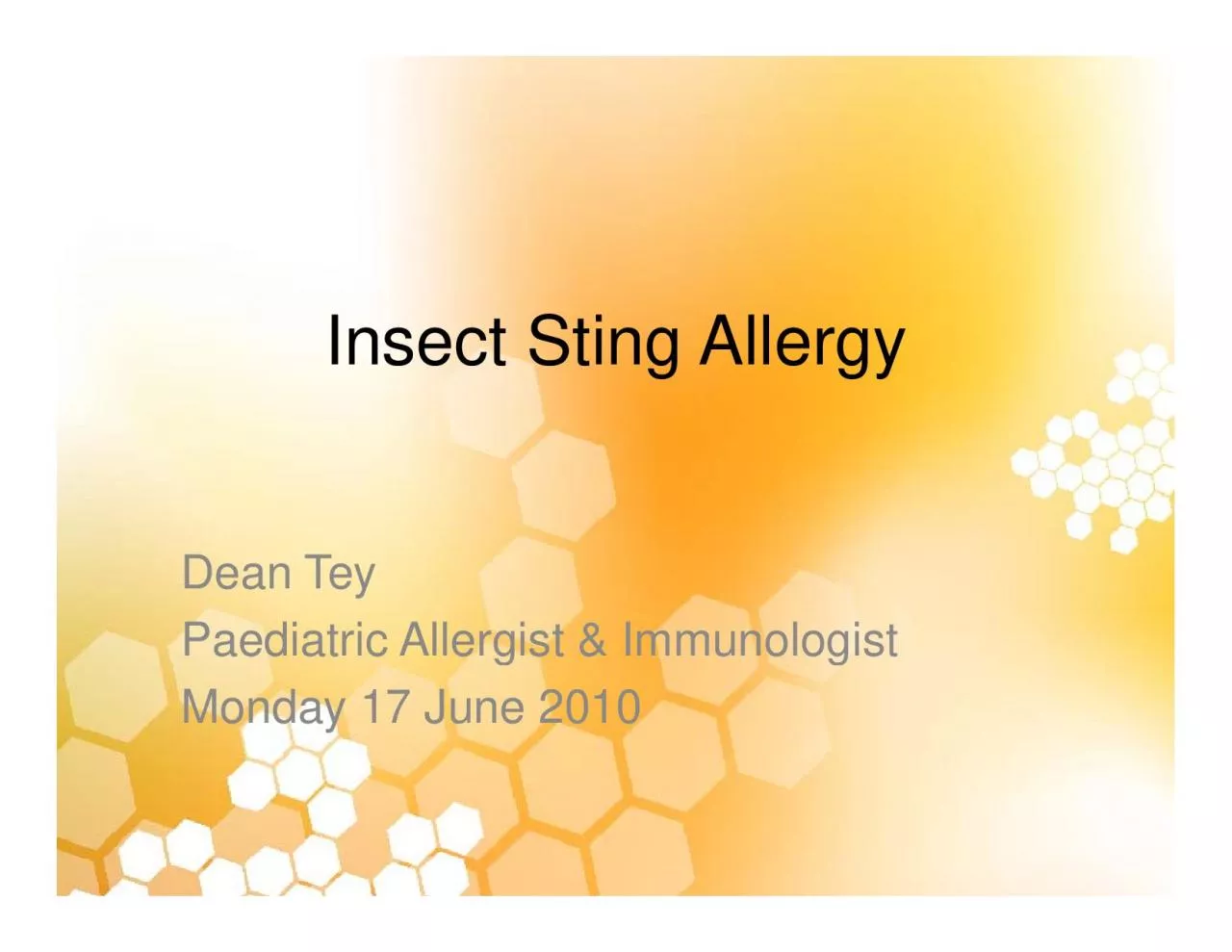

Dean Tey i All e r g i st Imm u n o l i st aedatcegstuoogst Monday 17 June 2010 InsectStingAllergy Insect 1E pgy 2Aetiology meet the insects3Clinical presentation 4Risk of future systemic r ID: 960547
Download Pdf The PPT/PDF document "Insect Sting Allergy" is the property of its rightful owner. Permission is granted to download and print the materials on this web site for personal, non-commercial use only, and to display it on your personal computer provided you do not modify the materials and that you retain all copyright notices contained in the materials. By downloading content from our website, you accept the terms of this agreement.
Insect Sting Allergy Dean Tey i All e r g i st & Imm u n o l i st aedatcegst&uoogst Monday 17 June 2010 InsectStingAllergy Insect 1.E pgy 2.Aetiology (meet the in
sects)3.Clinical presentation 4.Risk of future systemic reactions5.Investigations 6.Managementa)Prevention Localreactions c)Systemic reactions ) Venom immunotherap y ) y
Epidemiology Epidemiology In Australia, approximately 1200 admissions peryearattributedtowardshornetwaspor per bee stings (2002-2005) In Australia, approxi
mately 2 cases per year (20casesbetween1997 - I�n USA, 50 cases per year. 1.Bradley C. Australian Institute of Health and Welfare; 2008. Catalogno. INJCAT
110.2.Liew et al; JACI 2009;123:434-42.3.Barnard JH. JACI 1973;52:259-64. InsectStingAllergy Insect 1.E pgy 2.Aetiology (meet the insects)3.Clinical presentation 4.R
isk of future systemic reactions5.Investigations 6.Managementa)Prevention Localreactions c)Systemic reactions ) Venom immunotherap y ) y Yellow jackets Major allergen Ve
sv 5 Yellowandblackincolour Yellow Smooth thorax and abdomenIll temperedNests concealed in the ground or behind iditiill s ng or re t a i n i ng wa ll Scaven
ge for rotting fruit (found near garbage cans, dumpsters and orchards)Most common cause of insect stin g JkJAt g reactions because they are disturbed when gardening an
d lawn mowing J ac J t Colour is black, or red-and-blackYellow/orange legs, antennae and mandibles mandibles Most common in Tasmania. In Victoria, Have a characteris
tic jumping motion hittd w h en ag it a t e d Highly territorial and may fight with ants Photograph courtesy Alex Wild. ://www.m Cross-reactivit reactivit ORDER:HYMENO
PTERA have limited FamilyGenus/Species Apis(Honeybee) mellifera (Europeanhoneybee) and the vespid venoms 1 mellifera honeybee) Bombus(Bumblebee)Vespidiae (Wasps) Vesp
ulaand Dolichovespula(Yellow jackets or wasps ) (Wasps) wasps ) Vespulagermanica(European/German Wasp)Vespulavulgaris(Common wasp) Vespa(Hornets)Polistes(Paper
wasps) (At) Myrmecia(Bullants) ill (Jkjt) t s ) M j umper an t) 1. Golden DBK. JACI 2005;115:439-47. InsectStingAllergy Insect 1.E pgy 2.Aetiology (meet the insect
s)3.Clinical presentation 4.Risk of future systemic reactions5.Investigations 6.Managementa)Prevention Localreactions c)Systemic reactions ) Venom immunotherap y ) y Hist
ory importantaspects History Current sting Identify the particular insect involvedSingle (bee) versus multiple stings (wasp)Presence of sting (honeybee or Yello
w jacket) Tiffi Ti me o f onset o f react Signs of anaphylaxis (note: hoarse voice, coughing)Previous stings Severity of previous reactionsNumber of stings h e g
i espec a Oteaegesespecayasta Social historyRisk of future sting? E.g. beekeepers Timetonearesthospital? Time 1.Golden DBK. Immunol Allergy Clin N Am 2007;17:
261-272 Riskofsystemicreaction Risk A s y m p atients with a p ositive yppp diagnostic venom test (skin test or sIgE)15-25% of adults have a positive venom tes
t Thisiscommonlytransientwith12%ofsubjects becoming negative every yearThe risk of systemic reaction to a subsequent ti17%(11/65bjt)dt0% s ng was 17% (11/6
5 su bj ec ) , compare d t 0% in patients with a negative skin test (0/160) A n ex p lanation ma y be that a variable p ro pypp of these IgEantibodies are directed
against the CHO determinants that cross-react with foods 1.Golden et al. JAMA 1989;262:240-2442.Golden et al. JACI 1997;100:760-6.3.Hemmer et al. JACI 2001;108:1045-52.
Investigations Investigations Whotoinvestigate? Diagnostic tests are indicated when the risk futureofanaphylaxisisjudgedtobehigh(ie future . e T
hesearesubjectswhereimmunotherapyis being considered InsectStingAllergy Insect 1.E pgy 2.Aetiology (meet the insects)3.Clinical presentation 4.Risk of future
systemic reactions5.Investigations 6.Managementa)Prevention Localreactions c)Systemic reactions ) Venom immunotherap y ) y Investigations Investigations Insect venom
skin test InsectvenomspecificIgE Insect Sting challenge Consideredimpracticalandunethical 12 Considered 1 , 2 Even when sting challenge causes no rea
ction there remains a 15-20% chance of a s y stemic reaction from a subsequent sting3 1.vanderLindenet al. JACI 1994;94:151-92.ReismanRE. JACI 1993;91:11003.Franken et a
l. JACI 1994;93:431-6 Investigations Investigations Insectvenomskintest The preferred diagnostic method Highdegreeofsensitivity�(65%)andproven High
UseincomplementwithvenomsIgE 15-20% with positive skin tests have negative g E 5-10% with negative skin tests have positive sIgE 1.Hamilton RG. Cur r
Opin llergy ClinImmunol2004;4:297-3062.Allergen immunotherapy: a practice parameter second update 2007;JACI;120:S25-S85.3.Sobotkaet al. J Immunol1978;121:2477-844.Golden
et al. JAMA 1989;262:240-4. InsectStingAllergy Insect 1.E pgy 2.Aetiology (meet the insects)3.Clinical presentation 4.Risk of future systemic reactions5.Investigatio
ns 6.Managementa)Prevention Localreactions c)Systemic reactions ) Venom immunotherap y ) y Management Management 2 Localreactions 2 . Acute management OralH1 antihista
mines:usesecondgeneration - : Oral corticosteroids: consider if oedema is Ice pack and simple analgesia Atibitilid A n o cs are rare l y requ i re Reassure
and explain natural history of 10% chanceoffuturesystemicallergicreaction chance 1.Moffitt et al. JACI 2004;114;869-86.2.Severino et al. Current Opinion in Al
lergy and Clinical Immunology 2009;9:334-337 VenomImmunotherapy Venom Aims Aims Indicated in patients with positive diagnostic testandsystemicreactiontoasting 1
a Ultimate goal is to prevent fatal anaphylaxis 1.Moffitt et al. JACI 2004;114;869-86.2.Golden DBK. JACI 2005;115:439-47 VenomImmunotherapy Venom Efficacy Eff
icacy Without VIT, risk of anaphylaxis is 40-60% allergic reaction WithVITriskof reaction reduced to 5%()t15% 5% ( t 15% 1.Golden DBK. JACI 2005;115:439-47.2.Ler
ch et al. JACI1998;101:606-12. VenomImmunotherapy Venom Riskfactorsforrelapse 1.More severe allergic reaction on history 2 Honeybeeallergy 2 . 3.Systemic reac
tion during VIT 4 Lessthan5yearsofVIT 4 . 5 1 MulleretalJACI1992;89:529 4 etalJACI1998;101:606 1 . - 2.Golden et al. JACI 1998;101:298-3053.Golden et al. JA
CI 2000;105:385-90 4 . - 5.Reismanet al. JACI 1993;92:831-66.Keating et al. JACI 1991;88:339-48 Summary Summary 4 VITreducestheriskofasystemicallergic 4 . reduces t
he a reaction to 5% (wasp) to 15% (bees) 5 RiskofrelapsefromVITisincreasedin 5 . relapse subjects who have had: 1) a more severe allergicreaction
,2)honeybeeallergy,3) allergic reaction, allergy, systemic allergic reaction during VIT, and 4) y ears of treatment ; 6.Venom skin test or serum sIgEis unhel